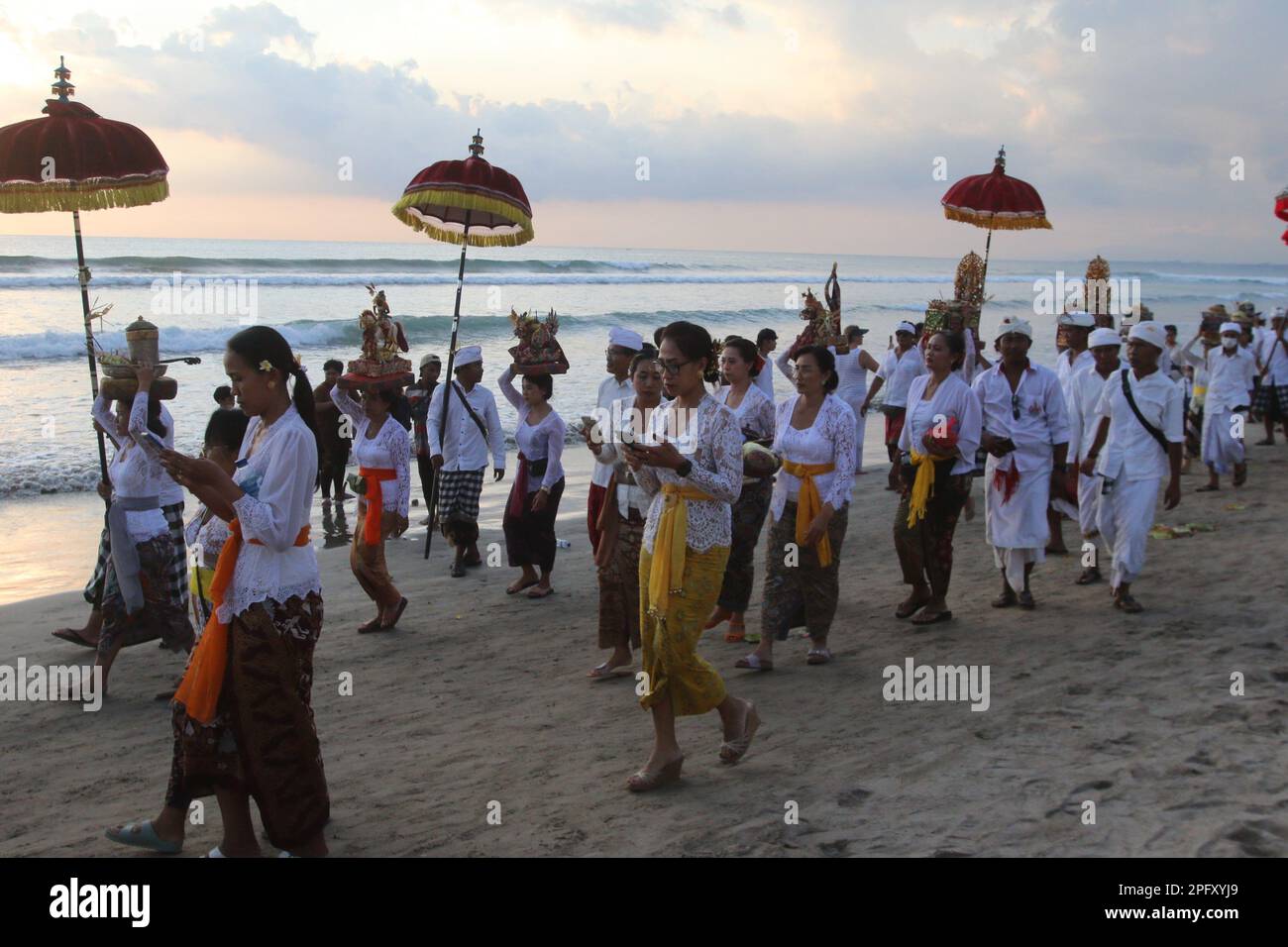Highlights: A Symphony of Spirit and Sea
As a seasoned traveler, I can tell you that witnessing the Melasti ceremony at Kuta Beach is an experience that transcends mere tourism. The atmosphere transforms the usually bustling Kuta into a sacred arena. Days before Nyepi, thousands of Balinese Hindus, adorned in their finest traditional attire – pristine white kebayas and sarongs for women, and white shirts with sarongs and headwear (udeng) for men – embark on a solemn procession. From various village temples, they carry their sacred effigies (pratima) and temple heirlooms to the sea.
The natural scenery of Kuta Beach provides a majestic stage for this spiritual drama. The vast expanse of golden sand, usually dotted with sunbathers and surfers, becomes a moving canvas of color and devotion. The crashing waves, often a symbol of playful abandon, here represent the ultimate purifier. The air, typically filled with the chatter of tourists, now hums with the melodic cadence of gamelan music, the soft chants of priests, and the aromatic smoke of incense, creating an almost ethereal haze. Elaborate offerings, known as gebogan – towering arrangements of fruits, flowers, and cakes – are carried gracefully on the heads of women, adding to the visual splendor. It’s a powerful demonstration of faith, a collective cleansing of the spirit, mind, and body, and a purification of sacred objects, all in preparation for a new year. Have you ever felt such a profound connection to a culture, just by observing?
Activities: Beyond the Spectacle
While the Melasti ceremony is the undeniable star, your time around Kuta Beach offers a wealth of activities. Your primary "activity" during Melasti will be respectful observation. Find a good vantage point – perhaps slightly elevated or along the procession route – and simply absorb the incredible energy. Photography is generally permitted, but always be mindful and respectful. Avoid getting in the way of the procession or priests, and if you wish to take close-up photos of individuals, always ask for permission with a polite smile. This is a sacred ritual, not a performance, and understanding that distinction will enrich your experience immeasurably.

Beyond the ceremony, Kuta Beach itself invites exploration. Take a long walk along the shore, feel the soft sand beneath your feet, and perhaps catch one of Bali’s legendary sunsets. While the ceremony is taking place, the focus is on reverence, but at other times, Kuta is famous for beginner surf lessons – why not give it a try?
For a taste of local life, delve into the culinary scene. Kuta boasts countless warungs (local eateries) where you can savor authentic Balinese flavors. Don’t miss nasi goreng (fried rice), mie goreng (fried noodles), sate lilit (minced seafood or chicken satay), or fresh seafood grilled to perfection. Quench your thirst with a refreshing young coconut or a freshly squeezed fruit juice. Looking for unique souvenirs? The Kuta Art Market and various shops lining the streets offer a treasure trove of Balinese handicrafts, intricate wood carvings, silver jewelry, vibrant sarongs, and aromatic spices. Each piece tells a story, a perfect memento of your spiritual journey.
Travel Tips: Your Journey to Spiritual Enlightenment
- Best Time to Visit: The Melasti ceremony occurs a few days before Nyepi (the Balinese Day of Silence). The exact date varies each year, typically falling in March or April according to the Balinese calendar (Saka calendar). To ensure you witness it, check the specific dates for Nyepi in your intended travel year. Generally, Bali’s dry season (April to October) offers pleasant weather for overall travel.
- How to Get There: Kuta Beach is conveniently located just a short drive (around 15-30 minutes, depending on traffic) from Ngurah Rai International Airport (DPS). Taxis, ride-hailing apps like Grab or Gojek, and pre-booked airport transfers are readily available. If you’re staying in nearby areas like Seminyak or Legian, Kuta is easily accessible by scooter rental (for experienced riders) or taxi.
- Entrance Fees: There are no entrance fees to observe the Melasti ceremony itself. However, parking for scooters or cars might incur a small fee.
- What to Bring:
- Respectful Attire: While observing, it’s polite to wear modest clothing, ideally covering shoulders and knees. A sarong and sash (often available for purchase locally) are highly recommended.
- Camera: Capture the magic, but always be mindful and respectful of the sacred nature of the event.
- Water & Sunscreen: Bali’s sun can be intense. Stay hydrated and protected.
- Hat/Sunglasses: For added comfort.
- Etiquette:
- Maintain a respectful distance from the processions.
- Avoid walking in front of or disrupting any rituals.
- Dress modestly.
- Refrain from using drones directly over the ceremony or priests without explicit permission.
- Keep noise levels low.
- Nearby Attractions: Extend your cultural exploration with visits to Tanah Lot Temple (a stunning sea temple), Uluwatu Temple (perched on a cliff with mesmerizing Kecak dance performances), or explore the trendier cafes and boutiques of Seminyak and Legian, which are just a stone’s throw away.

Conclusion: A Memory Etched in Gold
The Melasti ceremony at Pantai Kuta beach is more than just a cultural event; it’s a window into the soul of Bali. It’s an invitation to pause, reflect, and connect with a deeply spiritual community. To stand on the shores of Kuta, surrounded by the vibrant energy of devotion, the rhythmic chants, and the ocean’s purifying embrace, is to experience Bali in its most authentic and awe-inspiring form. This unique fusion of ancient tradition and natural beauty will leave you with a profound sense of wonder and memories etched in gold. Isn’t it time you answered the call of this extraordinary island and embarked on your own spiritual and cultural adventure? Bali awaits!

